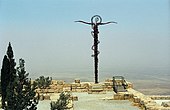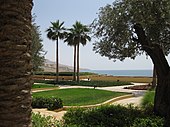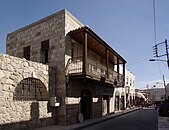|
Madaba Governorate
Madaba (Arabic مادبا) is one of the governorates of Jordan. It is located southwest of Amman, the capital of Jordan, and its capital is Madaba. The governorate is ranked 8th (of 12 governorates) by population and by area. It is bordered by Balqa Governorate to the north, The Capital Governorate to the east, Karak Governorate to the south and the Dead Sea to the west. History Many civilizations existed on the soils of Madaba, most prominent are the Moabites, Nabateans, Romans, and the Arab Muslim empires. The city of Madaba is best known for its Byzantine and Umayyad mosaics, especially the Madaba Map, a large Byzantine-era mosaic map of Palestine and the Nile delta. Biblical and ancient historyMany sites in Madaba Governorate are considered biblical sites, some of which are:
Many archeological excavations with pre-Biblical and Biblical emphases take part during the summer months in Madaba Governorate; new discoveries are being made each year. GeographyMadaba Governorate is bordered by Capital Governorate from the east and Balqa Governorate from the north, the West Bank across the Jordan River, and the Dead Sea from the west, and Karak Governorate from the south. Ma'in is a village in Madaba that is the site of a natural thermal waterfall. Its therapeutic effects are utilized by those with aching joints and skin irritations. a new tourist industry is growing around the site with the building of a new hotel and spa. The climate ranges significantly in the governorate due to the difference in altitude of the governorate's regions, the capital city of Madaba is at 798 meters above sea level, while the Dead Sea is at about 300 meters below sea level, resulting in a double digit difference in temperature between the two locations. EconomyTourismDue to its richness of historic sites, and natural sites such as the Ma'in Hot Springs and the Dead Sea, Madaba Governorate depends mainly on tourism as a main source of income. The governorate is the fifth touristic destination following Petra, Jerash, Aqaba, and Amman. AgricultureThe northern region of the governorate is agricultural, with a total area of 59 km2 of fruit and olive farms. The governorates production of olives and fruits is eighth on the kingdom (after Balqa, Irbid, Mafraq, The Capital, Ajloun, Jerash, and Zarqa governorates).[2] Administrative divisions Article 12 of the Administrative Divisions law of the Jordanian Ministry of Interior divides Madaba into two departments:
DemographicsThe population of districts according to census results:[3]
Gallery
References
|
||||||||||||||||||||||||||||||||||||||||||||||||||||||







